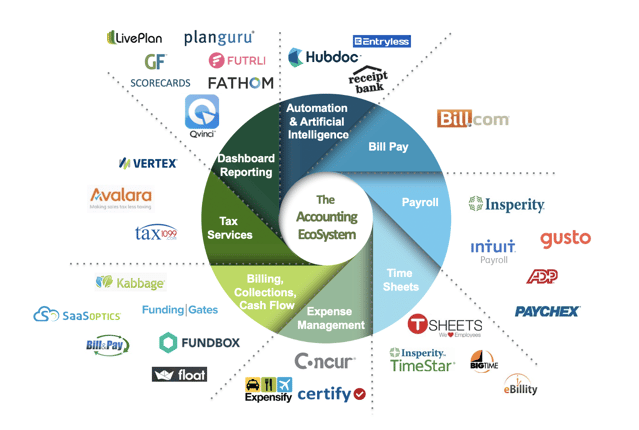5 min read


Out of the 33.2 million [1], 80% of small businesses in the United States aren’t taking complete advantage of the technology tools that are available to them- according to a recent Google report [2].
|
Key Takeaways
|
But… why? Small business owners often resist new technology for a variety of reasons, including perceived cost barriers, lack of understanding, or they think technology tools don't apply to their industry.
Yet, these notions about new technology innovations are wrong.
The rise of technology has driven changes in small businesses and consumer expectations. Growth-minded small businesses who readily adapt to new technology stand to benefit greatly with increased revenue, more efficient operations, reduced expenses, and faster growth.
You need to stay ahead of the curve.
Adapting to New Technology Is More Important Now Than Ever Before
If there's ever been a year that pushed businesses to adapt, 2020 and 2021 was it.
In businesses and organizations across all industries, offices were forced to decentralize, acclimate to working remotely, and determine how best to continue serving their clients in the midst of rapidly shifting operating conditions, rules, and health safety regulations. For many, adopting new technology was the clear solution to keeping up with the ever-changing business climate.
Now that consumers and employees are accustomed to the changes, some things might never return to how they were before the pandemic.
While businesses everywhere continue to adjust the way they operate, these are the small business technology trends to watch out- and prepare- for in 2022.
Top 7 Small Business Technology Trends of 2022
1. Decentralized Operations
Even before the start of the pandemic, many businesses were realizing the benefits of nixing their brick and mortar offices (lower overhead costs and a desirable work-life balance for employees) in favor of adopting remote operations. As pandemic-related closures started rolling out across the country, many businesses were forced to adapt to a decentralized operating scheme.
Once the world returns to something more similar to normal, you might decide to have your business return to regular in-person operations. Perhaps, you'll partially return to in-person operations with a mix of remote workers and on-site employees. Or maybe you'll find that a completely decentralized office actually makes more sense for your company.
Whatever you decide is the best long-term operating strategy for your business, in 2021, adopting remote working capabilities is going to be essential.
When it comes to operating smoothly during the pandemic, remote work technology means more than finding a video conferencing platform that meets your needs.
Businesses will rely heavily on cloud-based programs and data storage. Additionally, finding remote human resources technology will be key to maintaining a solid foundation of employees. This includes software for advertising open positions, interviewing, hiring, and onboarding in addition to software that allows you to keep track of your existing employees, the hours they work, and the benefits they use.
2. Technology-Assisted Client Interactions
With remote work and decentralized operations, the need for technologically advanced client interaction arises.
While small businesses often rely on their high-quality, person-to-person service models to compete, they've had to adapt to less personal customer interactions and tech-assisted transactions to stay relevant against a backdrop of enterprise-level companies that were able to make the shift to offering no-contact services much more quickly.
Encourage your service team to capitalize on new video communication technologies and host Face-to-Face virtual meetings. As we all know the power of eye contact, facilitating these meetings will help maintain the personal relationship and open communication with clients.
More and more softwares and applications are popping up to make this more convenient for your service teams. For example- Loom allows employees to record and share video messages of themselves, their screen, or both- and seamlessly it sends over email. Not only is this faster than an email or meeting live, but it also adds a personal touch.
With the ease and convenience of tech-assisted transactions, your clients will likely continue to use these services long after the need for no-contact service disappears and the world returns to normal.
3. Gig Economy Growth
With the rise of technology and its ability to connect freelance workers or independent contractors with potential clients everywhere, the gig economy is growing fast.
Gig economy workers comprise an estimated 36% of the workforce in the United States, and if the gig economy continues expanding at its current rate, it's estimated to overtake 50% of the country's workforce by 2027 [4].
What does this mean for small business owners? A couple of things...
First, you may find yourself competing for skilled employees as the gig economy continues to offer attractive alternatives to traditional career paths. You may need to consider adapting your business model to offer increased flexibility and benefits to your employees. This could mean taking steps to actively improve your company's culture, offering desirable employee benefits/rewards/recognition, and being open to the idea of employees working from home at least part of the time.
The second way the growing gig economy will impact your business is by giving you access to a host of incredibly talented working professionals that you can leverage to improve your business operations at a fraction of the cost of hiring full-time employees. A growing gig economy means you can outsource parts of your company that are not related to your primary function. This includes marketing, accounting, human resources, logistics, and more.
Consider outsourcing your non-core competencies. From an operational perspective, outsourcing is a form of automating processes. The main difference? Rather than a software executing the process, it’s completed by humans- experts- in a given field. Plus- outsourcing is typically 30-40% cheaper than hiring in-house.
As the gig economy continues to grow (and it should, barring any prohibitive regulatory changes), be prepared to harness its potential and grow your business along with it.
4. Artificial Intelligence and Automation
We all know the benefits of automation in your small business: higher productivity, cost saving, increased compliance, better financial insight- the list goes on.
Along with automating manual processes, small businesses can look into adopting and integrating technologies that use artificial intelligence to automate a variety of repetitive tasks. Whether you have an AI bot respond to basic online inquiries or adopting software that automates data collection and entry, AI will have an ever-increasing presence in small businesses in 2022.
Business leaders who begin integrating AI technologies into their operations will benefit by being ahead of the curve as these advancements only become increasingly integral in the future.
By reducing the time employees need to complete their work, as well as the number of employees needed on each task, automation and AI translates to more hours focused on doing work that drives profit. Your employees will be able to focus on high-level work that drives your business forward.
5. Advertising + Connecting Digitally
Businesses are finding it's more important now than ever to find creative ways to break through the digital noise and keep your brand relevant. Thanks to the current digital marketing and social media landscape, your sales and marketing team will have a variety of easy-to-use platforms to stay connected with both prospects and clients.
This year and further into the future, advertising models will continue to shift toward digital media, social media advertising, and influencer marketing as well.
In particular, event-based marketing will be replaced by community marketing. There has been an explosion of virtual events. Through 2022, people will still want to find ways to be intimately connected on Zoom and other platforms.
“That's why digital leaders across industries tell us they plan to spend, on average, 25% more on digital marketing. And 25% is just the average — some plan to spend significantly more”
Kevin Alansky, Chief Marketing Officer at Higher Logic
Don't be afraid to get your feet wet and invest in a marketing social media marketing campaign. Entry costs are low, and you might be surprised at how effective this advertising model can be. Make sure your sales and marketing department are fully armed with everything they need to stay relevant, in-touch, and top of mind with your ideal client profile.
In addition, these digital communication tools are a great way to keep your current client’s informed of your current business operations, relay supportive messages, and provide upbeat content during a tough time.
6. Software Integration
As small businesses increasingly adopt new technology tools, there will be an increasing need for software integration.
What does this look like? Software integration is the process of bringing various software systems together to make one unified system. Just like you have different employees bring different skill sets to work together- softwares integration is the same thing. Different applications “talk” and “work” together to complete a goal.
For example, when your service team updates a customer's address in one platform, you want it to automatically update in the other ten where it's stored. With the growing demand for a unified software solution, be on the lookout for new platform integrations that will save time and increase accuracy across your company's department.
Start by looking at ways to integrate your back office.
Technology integrations allow for more data in your accounting system, more quickly, eliminating errors, and at a lower cost than with manual processes. Here are a few of our favorite apps that can integrate with QuickBooks (from bill payment, to time tracking, to expense management and payroll.)

This will also help free up your employee’s time, which translates to more labor hours for you.
7. Heightened Cybersecurity
Cyber attacks put businesses at risk of incurring financial losses and reputational damage when your personal information and your client’s personal information are exposed. As more and more business functions move online and into the cloud, cybersecurity becomes increasingly important. Not only do employee's risk a personal data breach, but proprietary company information is also more vulnerable.
According to research from BullGuard, 60% of small business owners don't think they'll be the target of a cyberattack. Unfortunately, 61% of small businesses fall victim to cybersecurity breaches [4].
Take these steps now to strengthen your business's online security- this will not only help protect your employees, but also your client’s information
- Update your software regularly.
- Invest in end-to-end encryption software for online and point of sale transactions.
- Provide regular employee training regarding the recognition of online scams, phishing, and malware.
- Implement security protocols and processes for passwords and physical security on-site.
- Hire an IT expert in your business or a consultant to assist you throughout the year.
Start by Automating Your Back Office with QuickBooks and Easily Integrated Tools
Small business owners who wish to catch up with the technological times or get ahead of the curve can start by optimizing and automating their back office.
Bookkeeping and accounting tasks are repetitive, time-consuming, and rife with potential for human error, making them the best place to start applying the latest technology tools in your business.
You'll save valuable time and financial resources while freeing up your employees to focus on higher-value tasks. Plus, you'll have actionable financial data always at your fingertips, allowing you to identify which small business tech trend you should take on next.
[1] https://www.lawnstarter.com/blog/statistics/small-business-statistics/
[3] https://www.smallbizgenius.net/by-the-numbers/gig-economy-statistics/#gref
[4] https://www.prweb.com/releases/new_study_reveals_one_in_three_smbs_use_free_consumer_cybersecurity_and_one_in_five_use_no_endpoint_security_at_all/prweb16921507.htm


